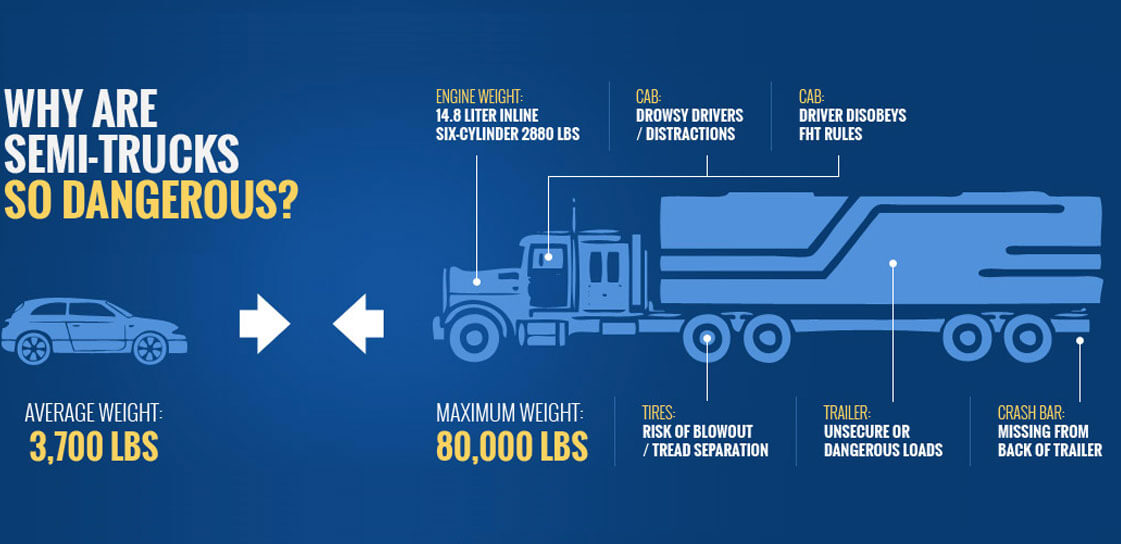 Albuquerque residents know that traveling throughout their beautiful state of New Mexico can be challenging. Due to the extreme climate differences between areas of high elevation and the low desert plains, drivers can find themselves navigating through a snow squall one minute and blasting the car’s air conditioner an hour later.
Albuquerque residents know that traveling throughout their beautiful state of New Mexico can be challenging. Due to the extreme climate differences between areas of high elevation and the low desert plains, drivers can find themselves navigating through a snow squall one minute and blasting the car’s air conditioner an hour later.
Long-term New Mexico residents would not be surprised to encounter livestock on a rural road in the middle of the night, while tourists may drive off the road in shock.
These unique features present challenges to any driver, our Albuquerque truck accident attorney says, but they can present a dangerous hazard to semi-truck drivers and the cars in their paths.
Many drivers misunderstand the complexities of these situations, which is why we encourage readers to explore the 4 Myths About New Mexico Semi-Truck Accidents to better understand liability, fault, and the real risks truck drivers face across the state.
Truck Crash Statistics in New Mexico
According to the New Mexico Department of Transportation Annual Traffic Crash Report, heavy trucks were involved in 1,894 crashes in New Mexico in 2013, resulting in 47 fatalities. Despite accounting for fewer than five percent of all crashes in the state, truck crashes caused 15 percent of the traffic deaths that year. To make matters worse, truck crash fatalities are on the rise in New Mexico, with an increase of 50 percent between 2009 and 2013.
With relatively low traffic volumes throughout the state, what is causing nearly 2,000 truck crashes every year? We examine some of the contributing factors here.
Long, Lonely Roads
New Mexico’s two major trucking routes—the north/south I-25 and the east/west I-40—run for many miles between cities and truck stops. For many truckers, our personal injury lawyer says, New Mexico is just a state to pass through on their way to or from California or Texas, and they try to do this as quickly and with as few stops as possible. This can lead to drivers engaging in behaviors that commonly cause truck-driver fault crashes, including:
- Fatigued driving. Despite the regulations in federal hours of service rules, some truck drivers still drive while fatigued. The 400-mile stretches of both I-25 and I-40 through New Mexico invite drivers to push their limits. If a driver is on a tight schedule to reach Los Angeles, for example, he may not hesitate to falsify his driving log in order to get through New Mexico and closer to his destination, no matter how tired he is.
- Speeding. Unlike many states, New Mexico does not have a lower speed limit for semi-trucks, so trucks can legally barrel down the interstates at 75 miles per hour—a speed that many think is unsafe for large trucks, particularly at night. If you happen to be returning to Albuquerque with your family from a day trip to Santa Fe and encounter a semi-truck pushing 80 mph, you will quickly become aware of this potential danger.
- Distracted driving. Long, straight, empty roads are also an invitation to a trucker to call home, check email or Facebook, or do any number of other things behind the wheel of his truck. This kind of multi-tasking is extremely dangerous and increases the chance of an accident by 24 times, according to the Federal Motor Carrier Safety Administration.
- Navigating unfamiliar roads. Known as the “Big-I,” the I-25/I-40 interchange in Albuquerque is complex and confusing for all drivers, but presents a particular hazard to truck drivers who are unfamiliar with the area. Reading signs and figuring out where to go while controlling a big rig is very difficult. In fact, navigating unfamiliar roads is often cited as a major cause of truck crashes nationwide. The Big-I and the many smaller connector routes throughout New Mexico frequently contribute to truck crashes.
Wild Weather
Hazardous weather conditions contribute to crashes and major pile-ups throughout the country. However, in most states, drivers know what to expect according to the season. New Mexico’s unique geography, however, creates unpredictable weather patterns that can surprise truck drivers and cause accidents. Some of these weather hazards include:
- Flash floods. Spring snow melts from the higher elevations and summer rainstorms can quickly lead to flooding of the normally dry conditions throughout New Mexico. These flash floods can wash out roads, deposit debris on roadways, and fill low-lying roads with deep water. Truckers who do not pay attention to weather alerts could add to the danger of flash flooding by continuing to drive.
- Snow. While snowfall is expected and welcomed in New Mexico’s mountains, many drivers are surprised by winter blizzards and spring snow squalls throughout the state. Slick roads and poor visibility can quickly lead to traffic pile-ups; semi-trucks are often at the center of these driving disasters.
- Severe thunderstorms. Believe it or not, New Mexico has a “monsoon season” in July and August, bringing heavy downpours and a great deal of lightning. It is never safe to drive through one of these brief but powerful storms, and truck drivers must put aside their delivery schedules in the name of safety. Some drivers don’t.
- Glare and haze. New Mexico boasts 300 days of sunshine a year, which can also cause driving hazards with glare in a truck driver’s eyes and a mirage-like haze across flat desert roads. Truck drivers must be especially aware of this hazard and slow down when their vision is compromised.






